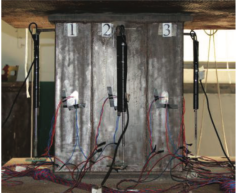[Structural Engineering]
Jiepeng Liu, Hua Song, Yuanlong Yang*. Research on Mechanical Behavior of L-shaped Multi-cell Concrete-filled Steel Tubular Stub Columns under Axial Compression[J]. Advances in Structural Engineering, 2019, 22 (2): 427-443.
Keywords: bearing capacity, concrete-filled steel tubular stub column, ductility, L-shaped column, multi-cell
High Lights:
> L-shaped multi-cell CFST stub columns were tested subjected to axial load.
> A finite element program was proposed and verified by the experimental results.
> A design method of bearing capacity considering constraint effect was determined based on the comparison of bearing capacities in codes.
Abstract:
A total of 11 L-shaped multi-cell concrete-filled steel tubular stub columns were fabricated and researched in axial compression test. The key factors of width-to-thickness ratio D/t of steel plates in column limb and prism compressive strength of concrete fck were investigated to obtain influence on failure mode, bearing capacity, and ductility of the specimens. The test results show that the constraint effect for concrete provided by multi-cell steel tube cannot be ignored. The ductility decreases with the increase of width-to- thickness ratio D/t of steel plates in column limb. The bearing capacity increases and the ductility decreases with the increase in prism compressive strength of concrete fck. A finite element program to calculate concentric load–displacement curves of L-shaped multi-cell concrete-filled steel tubular stub columns was proposed and verified by the test results. A parametric analysis with the finite element program was carried out to study the influence of the steel ratio a, steel yield strength fy, prism compressive strength of concrete fck, and width-to-thickness ratio D/t of steel plates in column limb on the stiffness, bearing capacity and ductility. Furthermore, the design method of bearing capacity was determined based on mainstream concrete-filled steel tubular codes.
